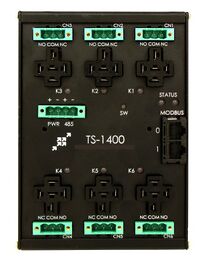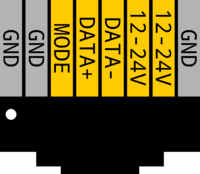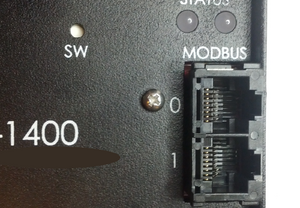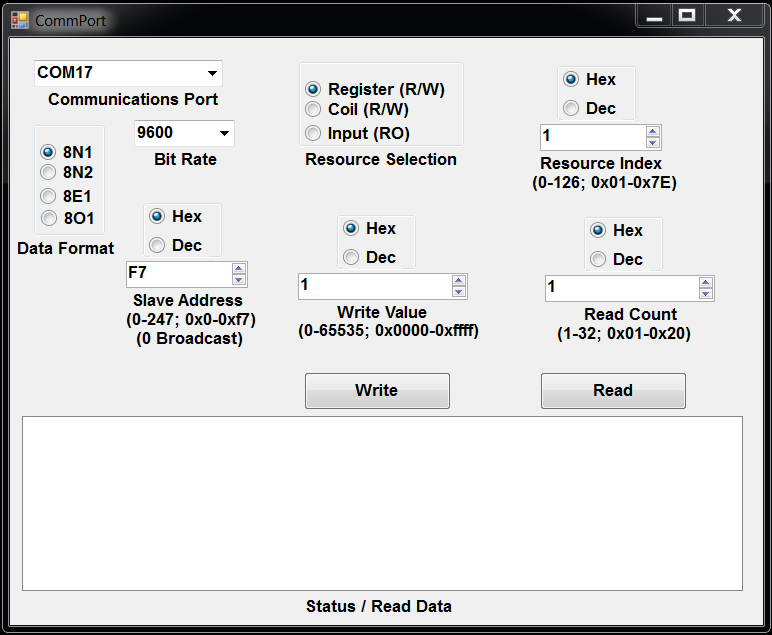TS-1400
 | |||
| Concept March 2013 | |||
| Product Page Removed / Product Not For Sale | |||
| Documentation | |||
|---|---|---|---|
| FTP Path | |||
| Relays | |||
| External Interfaces | |||
| 2x RJ45 Modbus | |||
| Power Requirements | |||
| 24V | |||
| Operates between 0.435W-9.75W | |||
| Operating Temperature | |||
| |||
| |||
| Mechanical | |||
| 164mm x 112mm | |||
| Height 58mm (with relays) | |||
| Weight 467g | |||
Overview
The TS-1400 is a modbus peripheral device which features 6x 24VDC 30A relays.
Getting Started
Using TS-ARM Products
Our TS-ARM products use Debian Linux which can use Modbus to communicate with the TS-1400. We have created a patch to libmodbus to allow guaranteed timing which is available here. For ARMEL(EABI) compatible systems we have debian package here.
To install this on a board, connect it to the internet and run these commands:
wget https://files.embeddedTS.com/ts-modbus/libmodbus_3.0.3-1_armel.deb
dpkg -i libmodbus_3.0.3-1_armel.deb
This package includes both the library and the supporting headers needed for building libmodbus compatible examples. For other platforms other than OABI ARM you can use the sources provided by the libmodbus project.
Example Code
This code uses the patched libmodbus for xuart support communicating at 9600, 8n1, and with the default modbus address 247:
// TS-1400 Coil-toggle example.
// Written by Michael D Peters for Technologic Systems, Inc.
// Copyright March 22, 2013
//
// This code assumes six relays on a TS-1400 that is configured
// in legacy mode, 9600 baud, 8, N, 1, Device address 0xAC.
//
// This code assumes the use of the Technologic Systems XUART
// controller, xuartctl, and the appropriately modified version
// of Libmodbus. Patch files available near here:
// http://forum.embeddedTS.com/
//
// These settings are modifiable in the #define block below.
//
// This program demonstrates both methods of setting coils on
// the TS-1400.
// First by setting coils using the holding register address.
// Second by setting individual coils using the write coil command.
#include <stdio.h>
#include <stdlib.h>
#include <modbus.h>
#include <errno.h>
#define DEVICE_ID 0xf7
#define SPEED 9600
#define PORT "127.0.0.1:7350"
#define RELAY_REGISTER 0x40
modbus_t *mb;
int main(int argc, char* argv[])
{
int c = 0;
// modbus setup
mb = modbus_new_rtu(PORT, SPEED, 'N', 8, 1);
if(!mb){
fprintf(stderr, "Unable to open bus at port %s.\n", PORT);
return 0;
}
modbus_set_debug(mb, (argc > 1));
modbus_set_slave(mb, DEVICE_ID);
modbus_connect(mb);
// Demo functions
printf("Ticking relay pattern...\n");
c = set_multiple_relays();
if(c == -1){
return 0; // error output by function.
}
printf("Ticking individual relays...\n");
c= set_single_relay();
if(c == -1){
return 0; // error output by function.
}
return 0;
}
// throws relays in a 24 position countup -- that's 64 iterations.
// returns -1 and prints stderr if there was a problem,
// returns 1 if no trouble was detected.
int set_multiple_relays()
{
uint16_t c = 0;
int d = 0;
for(c = 0; c < 64; c++){
d = modbus_write_register(mb, RELAY_REGISTER, c);
usleep(100000);
if(d == -1){
fprintf(stderr, "Problem with write. Error %d: %s",
errno, modbus_strerror(errno));
return -1;
}
}
return 1;
}
// Throws relays individually using the write relay modbus command.
// Throws each relay on and then off in sequence.
// Returns -1 if error condition and writes an error to stderr. Returns 1 otherwise.
int set_single_relay()
{
int c = 0;
int d = 0;
d = modbus_write_register(mb, RELAY_REGISTER, 0);
while(c<6){
d = modbus_write_bit(mb, c, 0xffff);
usleep(1000000);
d = modbus_write_bit(mb, c++, 0x0);
if(d == -1){
fprintf(stderr, "Problem with write. Error %d: %s",
errno, modbus_strerror(errno));
return d;
}
}
return 1;
}
To compile and run this as test.c:
gcc `pkg-config --libs --cflags libmodbus` test.c -o test
./test
Power Requirements
The TS-1400 requires 0.435W under normal operation, and approximately 1.6W for each active relay.
Features
TS Modbus Support
When using all Technologic Systems Modbus devices we include functionality to create an arbitrary chain of stock peripherals to automatically enumerate all connected devices, configure them, and generate an I/O map of all connected devices.
TS Modbus Autoconfiguration
The autoconfiguration works by using the optional mode pin on the RJ45 connector as designated in the MODBUS-2W standard. Technologic Systems uses this to indicate if it is a TS device. If it is asserted (low) to a TS device, then it will allow access to the #Holding Registers at address 0xf7.
This will identify the TS Modbus device model, set the first device in the chain to the user specified slave address (default is 0x10), and assert the mode line to the next port to enumerate the next device. The next device address is incremented by 1, and the process is repeated until no slave responds to a read query (timeout)indicats that no additional devices are connected to the bus chain. At this point the last device in the chain is configured to enable bus termination on the RS485 link, and all devices have their bit rates set to the user selected bit rate (default is 9600).
Register Interface
Holding Registers
The interface to all Modbus peripheral devices consists of a set of 127 holding registers. These registers are used to configure the device operation, read and write input output parameters, as well as various settings used to configurable Modbus Address, Termination enable, Data Format, and Bit Rate. These settings are common to all of our Modbus peripherals and can be persisted in on-board flash memory.
NOTE: The device operates ONLY in Modbus RTU communications mode. Modbus ASCII is not presently supported.
| Address (hex) | Address (dec) | Access | Description | Example Values |
|---|---|---|---|---|
| 0x70 | 112 | Read/Write | Modbus Mode | 0 = ASCII (unimplemented), 1 = RTU |
| 0x71 | 113 | Read/Write | RS485 Bus Termination Enable | 0 = Termination disabled, 1 = Termination enabled |
| 0x72 | 114 | Read/Write | Modbus Device Address | 0-247 (0x00-0xf7) 0 = Broadcast |
| 0x73 | 115 | Read/Write | Modbus bit rate | Bit Rate |
| 0x74 | 116 | Read Only | Unit Model | e.g., 0x1400, 0x1700, 0x1800, etc |
| 0x75 | 117 | Read Only | Verilog Version | e.g., 1 |
| 0x76 | 118 | Read Only | ZPU Version | e.g., 1 |
| 0x77 | 119 | Read Only | Bus power Supply in millivolts | e.g., 23600 |
| 0x78 | 120 | Read Only | Internal Temperature in 1/100th degree Celsius | e.g., 290 |
| 0x79 | 121 | Read/Write | Reserved or model specific | Not applicable or model specific |
| 0x7a | 122 | Read/Write | Reserved or model specific | Not applicable or model specific |
| 0x7b | 123 | Read/Write | Reserved or model specific | Not applicable or model specific |
| 0x7c | 124 | Read/Write | Reserved or model specific | Not applicable or model specific |
| 0x7d | 125 | Read/Write | Write listed value to persist communications (Bit rate, Data format, Address, and Termination) parameters to internal nonvolatile storage: | 0xFEED = Persist configuration, 0xDEAD = Erase configuration, 0xC0DE apply configuration without persistence. In all cases the value is set to zero when completed or 0xFA17 (FAIL) if error. |
| 0x7e | 126 | Read/Write | Reserved or model specific | Not applicable or model specific |
NOTE: All Read Only registers may be written; however, writing to certain registers (e.g., Unit Model) will overwrite the information that will not be refreshed until the unit is reset.
Baud Rate
The TS-1400 supports 15 speeds:
| Value | Communication Bit Rate | Maximum CAT5 Cable Length |
|---|---|---|
| 0 | 300 | 1200 meters |
| 1 | 600 | 1200 meters |
| 2 | 1200 | 1200 meters |
| 3 | 2400 | 1200 meters |
| 4 | 4800 | 1200 meters |
| 5 | 9600 | 1200 meters |
| 6 | 19.2K | 1200 meters |
| 7 | 38.4K | 1200 meters |
| 8 | 57.6K | 1200 meters |
| 9 | 115.2K | 800 meters |
| 10 | 230.4K [1] | 400 meters |
| 11 | 460.8K [1] | 200 meters |
| 12 | 1040K [1] | 100 meters |
| 13 | 2080K [1] | 40 meters |
| 14 | 4160K [1] | 20 meters |
Operating Registers
Coil addresses correspond to the appropriate relay (coil 0 == CN1). Holding Register 0x40 is read/write and always reflects the current status of each coil in the first six bits: Holding Register 0x40 bit 0:5 == Coil Register 0... 5 == Physical Relay 1... 6.
| Address (hex) | Address (dec) | Access | Description |
|---|---|---|---|
| COIL 0x0 | 0 | Read/Write | Relay 0 (1 NO, 0 NC) |
| COIL 0x1 | 1 | Read/Write | Relay 1 (1 NO, 0 NC) |
| COIL 0x2 | 2 | Read/Write | Relay 2 (1 NO, 0 NC) |
| COIL 0x3 | 3 | Read/Write | Relay 3 (1 NO, 0 NC) |
| COIL 0x4 | 4 | Read/Write | Relay 4 (1 NO, 0 NC) |
| COIL 0x5 | 5 | Read/Write | Relay 5 (1 NO, 0 NC) |
| COIL 0x6 | 6 | Read/Write | Relay 6 (1 NO, 0 NC) |
| HOLDING 0x40 | 64 | Read/Write | Bits 0:5 correspond with Relay 1-6 |
Connectors
2x RJ45
Both RJ45 ports, and all of our Modbus based devices are designed to be compatible with 2W-MODBUS RJ45 following this pinout:

|
 |
Product Notes
Modbus Linux Utility Programs
Modbus Linux register access program: mbpeekpoke
root@ts4700:/home/zpu# ./mbpeekpoke -?
Usage: mbpeekpoke -switch parameter [OPTIOSN] ...
Download and start a ZPU program. Optionally persist the code
Default parameter values in [brackets]
-? This help screen
-b bit_rate Bit rate [9600]
300, 600, 1200, 2400, 4800, 9600, 19200
38400, 57600, 115200, 1000000, 4000000
-c connection IP:Port IP address:port [127.0.0.1:7350]
Serial port [/dev/ttySP2]
-D Device to access: [C]oil, [R]egister, [I]nput, [P]acket
-d Display packet debugging information [Off]
-f Register display output format:
'X' hex, 'S' signed decimal 'U' unsigned decimal [Hex]
-h This help screen
-n number_of_items number of items to read [1]
-m Board model # 7670 with serial [any other using TCP socket connection]
-r address Read: Device @ specified address
-s slave_address hexadecimal 00-f8; 00 is broadcast [0xf7]
-v data value to write
-V Verbose mode - display additional debug information
-w address Write: Device @ specified address
The (-w) write option requires a single (-v) variable
The (-r) read option can read a number of items with the (-n) switch
Both the -w & -r options may be used on the same or different addresses
however, they must both use the same device (-D) and the write is performed first
Modbus Linux register access program for TS-7670: mbpeekpoke7670
root@ts4700:/home/zpu# ./mbpeekpoke7670 -?
Usage: mbpeekpoke7670 -switch parameter [OPTIOSN] ...
Default parameter values in [brackets]
-? This help screen
-b bit_rate Bit rate [9600]
300, 600, 1200, 2400, 4800, 9600, 19200
38400, 57600, 115200, 1000000, 4000000
-h This help screen
-n number_of_items number of items to read [1]
-r address Read: Register @ specified hex address
-s slave_address hexadecimal 00-f7; 00 is broadcast [0xf7]
-u Use USB connection
-v data value to write
-w address Write: Register @ specified address
The (-w) write option requires a single (-v) variable
The (-r) read option can read a number of items with the (-n) switch
These programs are used to perform accesses to the Modbus devices register set. It allows the writing of arbitrary hex data to any hex register address one at a time and the reading of blocks of arbitrary data from any hex register addres displayed in hex, signed, or unsigned decimal.
Modbus Linux device configuration program: mb_config
root@ts4700:/home/zpu# ./mb_config -?
Usage: mb_config -switch paramater [OPTIOSN] ...
Configure a Modbus device for legacy mode by setting operational parameters
Default parameter values in [brackets]
-? This help screen
-b bit_rate Bit rate [9600]
300, 600, 1200, 2400, 4800, 9600, 19200
38400, 57600, 115200, 230400, 460800
1040000, 2080000, 4160000
-C Configuration Model 1700: 8 character field starting @ DIO bit 7 thru 0
Use single letters 'T' Temperature; 'I' Input: 'O' Output
All Other model: Not required
-c connection IP:Port IP address:port [127.0.0.1:7350]
-d Display packet debugging information [Off]
-f format (data) Data format: 8N1, 8N2, 8E1, 8O1, [8N1]
-h This help screen
-i Display I/O accesses
-I Inhibit actual writing
-m Board model # 7670 with serial [any other using TCP socket connection]
-n Noninteractive mode [off]
-p Display progress messages [Off]
-s slave_address hexadecimal 00-f6; 00 is broadcast [0x10]
-t termination Terminstion on / off [off]
-v verboce output mode
DIO Configration for Model TS-1700
root@ts4700:/home/zpu#
This program is used to perform configuration of a Modbus device. On older modbuc devices these settings (Slave address, Communications bit rate and data format, termination) would have been performed via DIP switches. This configuration information is stored in non-volatile memory on the device.
The primary difference in usage of these utilities depends on the hosting platform.
On SBC products using the XUART communications devices, the -c switch and parameter does not need to be specified, since the default communications port is correct.
On the TS-7670 with a standard UART communications device, the '-m 7670' switch should be specified. This allows the proper hardware setting for the RS-485 port to be utilized.
On SBC products with a host USB port for communications, the -c switch should be specified and paramater should be the USB to Serial communication device, which is generally '/dev/ttyACM0'. The '-s f6' switch and parameter is required since the unit operates at a different slave address when operating via USB. The bit rate does not need to be specified, since the USB port will operate at the fastest rate possible (up to approximately 1000000 bps).
Modbus Windows Utility Programs
Modbus Windows register access program: ModbusDeviceAccess
These programs are used to perform accesses to the Modbus devices register set. It allows the writing of arbitrary hex data to any hex register address one at a time and the reading of blocks of arbitrary data from any hex register addres displayed in hex, signed, or unsigned decimal.
- Use of this utility requires the following steps:
- 1. Select the COM port from the drop down box
- 2. Select the bit rate from the drop down box
- 3. Select the correct data format (8N1 is default)
- 4. Enter the connected device slave address after selecting the format (Hex or Decimal)
- NOTICE:The coil functionality is currently not functional in Windows
- 5. Select the resource type (Regoster, Input, or Coil)
- 6a. Set the resoucw index (e.g., Register number) and count for reading
- 6b. Set the resoucw index (e.g., Register number) and value for writing
- 7. Click the appropriate button to read or write the device
Modbus Windows device configuration program: ModbusDeviceConfigure
This program is used to perform configuration of a Technologic Systems Modbus device. On older Modbuc devices these settings (Slave address, Communications bit rate and data format, termination) would have been performed via DIP switches. This configuration information is stored in non-volatile memory on the device. This utility is designed to operate on devices confired as factory degault, 9600, N81, address 0cf7. Windows USB connections are not currently supported, so the devie should be connected via a TS-142 ISB to Serial Modbus adapter is required.
- Use of this utility requires the following steps:
- 1. Select the COM port from the drop down box
- NOTICE:The USB functionality is currently not operational on Windows
- 2. Select the COM port type (USB or Serial)
- 3. Click Identify
- The model willl appear at the top of the page
- 4. Select the Data Format, Slave Address, Bit Rate, and Termination
- 5. Click Configure
FCC Advisory
This equipment generates, uses, and can radiate radio frequency energy and if not installed and used properly (that is, in strict accordance with the manufacturer's instructions), may cause interference to radio and television reception. It has been type tested and found to comply with the limits for a Class A digital device in accordance with the specifications in Part 15 of FCC Rules, which are designed to provide reasonable protection against such interference when operated in a commercial environment. Operation of this equipment in a residential area is likely to cause interference, in which case the owner will be required to correct the interference at his own expense.
If this equipment does cause interference, which can be determined by turning the unit on and off, the user is encouraged to try the following measures to correct the interference:
Reorient the receiving antenna. Relocate the unit with respect to the receiver. Plug the unit into a different outlet so that the unit and receiver are on different branch circuits. Ensure that mounting screws and connector attachment screws are tightly secured. Ensure that good quality, shielded, and grounded cables are used for all data communications. If necessary, the user should consult the dealer or an experienced radio/television technician for additional suggestions. The following booklets prepared by the Federal Communications Commission (FCC) may also prove helpful:
How to Identify and Resolve Radio-TV Interference Problems (Stock No. 004-000-000345-4) Interface Handbook (Stock No. 004-000-004505-7) These booklets may be purchased from the Superintendent of Documents, U.S. Government Printing Office, Washington, DC 20402.
Limited Warranty
See our Terms and Conditions for more details.

